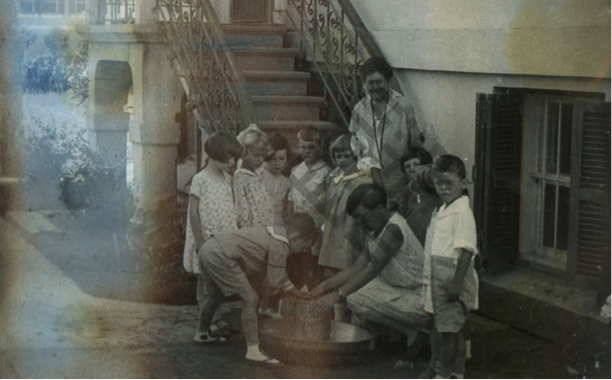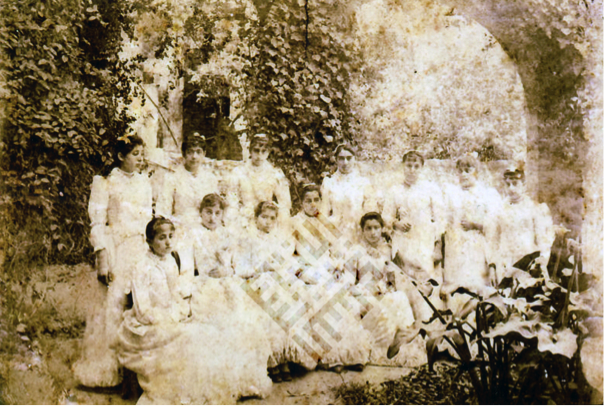The Desire for Progress in The Syrian World: Education
This article is authored by Dr. Akram Khater, Director of the Khayrallah Center for Lebanese Diaspora Studies and Khayrallah Distinguished Professor of Lebanese Diaspora Studies, and Professor of History at NC State, and Nicole Coscolluela, a second year MA student in Public History and completing the Digital Humanities Certificate at NC State.
The Syrian World was a publication started by Lebanese immigrants for Lebanese immigrants and those of Lebanese ancestry in the United States. In circulation from 1926 to 1935 and written in English, The Syrian World aimed to impart cultural knowledge to younger generations of Lebanese Americans. This blog post is Part 1 of 3 in a series on the concept of “progress” as Lebanese Americans saw it. Each part will address a different topic and this week’s post is on education.
“Behind them lies a rich and varied heritage of achievement representing ages past. Ahead of them stand the results and products of Western civilization with its blessings and curses, its nationalism, democracy, imperialism, commercialism and progressiveness.”
– The Syrian World, August 1927
The idea of “progress” in The Syrian World demonstrated a tension between a respect for the traditions of old Syria and visions for the new, modern Syria [1]. On the one hand, modernization symbolized reason, equity, democracy, and secularization. On the other, tradition evoked the Syrians’ proud Phoenician roots and rich cultural heritage that they did not wish to lose. The Syrian World sought to strike a balance between the two worlds, aiming to promote the benefits of both.

Syria was at a crossroads. When The Syrian World began its distribution in 1926, Ottoman rule in the area had dissolved by 1920 as Franco-British forces partitioned the lands of the former empire. What is now present-day Lebanon became a French mandate. There were opponents of the annexation and contrasting visions for the new state’s future. Christian opponents invoked rights to self-determination while Muslim opponents deemed the act and mandate an unjust system [2]. The Arab federalists wanted an independent Arab state; Syrian federalists were split; protectionists wished for France to annex Christian Lebanon; and Lebanese independentists imagined an independent, democratic, and multi-sectarian republic where Christians and Muslims coexisted [3]. Syria had choices in which to take the new country.
Syrian Americans had their own sets of ideas for their homeland. They exhibited common themes, one of the strongest being education. The September 1928 issue ran an article by Rev. W.A. Mansur titled “The Greatness of the Syrian Race,” which deemed it imperative that Syrians learn the “origin, history, and survival of their race [4].” Such knowledge was necessary for self-respect and progress. Without this, Syrians would not be able to work towards democracy, tolerance, freedom, and equal rights. Rev. Mansur argued that these were all qualities of a new social order and knowledge would supplant militarism and exploitation.
Bayard Dodge elaborated in 1929. “True education” would encompass three parts: technical training, culture broadening, and character building. He considered education as a basis for progress and a “cure-all for weakness [5].” Education was a means of avoiding catastrophe – not only would it allow Syria to enjoy scientific advantages but “differences of race and sect will disappear” and “superstition and bigotry will fade away.” It would foster teamwork and community service to do public good [6].

Striving for progress was rooted in Syrians’ Phoenician lineage. Modern Syrians benefited from a “religious, moral, and racial inheritance” and were imbued with “native talents [7].” Rev. Mansur described the Phoenicians as having “improved the alphabet, created sea ship-building, sea commerce, and emigrated for trade.” He praised them for propagating the “highest thoughts of man in religion, morals and society [8].” Since their ancestors contributed much to humanity, then so must modern Syrians. In a demonstration of cultural pride, Syrians should be an “undivided whole” which could then be “secured and preserved through universal education, equality in justice and non-discrimination [9].”
Despite feeling the need to respect Syrian roots, authors also saw the necessity to break with tradition in order to make progress. These attitudes were often directed at the status of women and the need for native schools. After World War I, feminism and the fight for women’s rights made their way into Middle Eastern socio-political discourse. The Women’s Union in Syria and Lebanon was formed in 1924, which encouraged women to demonstrate against injustices and to become involved in political issues [10]. Female leaders demanded for females an education equivalent to their male counterparts and topically-focused on their country’s history, culture, and religious denominations. They found it important for the lessons to be in Arabic.

Mary Ferguson of McComb, Mississippi was featured in the September 1926 issue and she pushed for equal access and opportunities for Syrian girls. She railed against “narrow-minded parents” hindering their daughters “in this modern age [11].” She argued that educated men want more than a wife that only knows how to cook and clean, the result being that Syrian men are unlikely to marry Syrian women because she would be an “embarrassment to him.” Ms. Ferguson called for women’s education for the sake of “improving the race” and making “Syrian young men proud of marrying Syrian girls [12].” However, it was not just women pushing for equality.
Philip Hitti suggested that education be free and compulsory for both males and females [13]. He also noted the popularity of native schools, especially the school for girls founded in Beirut by Marie Kassab [14]. He considered it a great achievement for a school to be established through Syrian initiative and be under total Syrian management. Hitti noted its increasing yearly enrollment, which included some boarders from the United States. Clearly, there was a demand for such a school and interest had transcended Syrian borders. Many Syrians recognized that a nation cannot progress if women are segregated from various fields of activity [15].

Progress for women’s rights also translated to everyday life. Lawyer Selim Totah observed that many women walk unveiled in Syrian cities and “those who are still veiled are wearing their veils thinner than ever [16].” He gave the credit not to the mandatory government but to the missionaries and private schools. Totah demonstrated Syrian mistrust of the Mandatories and promulgated the idea of “native” initiative. If any change was to take place, the first step must come from Syrians themselves. Their self-awareness and cultural pride would form the foundation for the progressive ideas they wished to see. To Syrian Americans, education – especially girls education – was a major step into achieving greatness and unity.
Sources
[1] “Syria” refers to what is now Jordan, Lebanon, Syria, and Israel.
[2] Fawwaz Traboulsi. A History of Modern Lebanon. London: Pluto Press, 2007. 88.
[3] Ibid. 82-83.
[4] Rev. W.A. Mansur. “The Greatness of the Syrian Race.” The Syrian World. Vol. 3, No. 3 (September 1928). 10.
[5] Bayard Dodge. “Education and Catastrophe.” The Syrian World. Vol. 3, No. 12 (June 1929). 6.
[6] Ibid. 8.
[7] Salloum Mozarkel. “The Changing East.” The Syrian World. Vol. 4 No. 5 (January 1930). 18.
[8] Rev. W.A. Mansur. “The Greatness of John Hasbani.” The Syrian World. Vol. 3, No. 12. (June 1929). 25.
[9] Jamile Kanfoush. “Mixed Marriages (Reader’s Forum).” The Syrian World. Vol. 1. No. 8. (February 1927). 52-53.
[10] Judith Cochran, Mona Nabhani, Rima Bahous, and Rewa Zeinati. “Leadership in the Middle East: The Story of Women in Lebanon.” Middle East Institute. October 13, 2010. http://www.mei.edu/content/leadership-middle-east-story-women-lebanon
[11] Mary McComb. “Pleads Educating Syrian Girls.” The Syrian World, Vol. 4 No. 1. (September 1926). 57.
[12] Ibid.
[13] Philip Hitti. “The Rediscovery of an Ancient Empire – the Hittites.” The Syrian World, Vol. 1. No. 8. (February 1927). 51.
[14] Philip Hitti. “Educational Society Helps Native School.” The Syrian World, Vol. 1. No. 8. (February 1927). 57.
[15] “Druze Girl Talks to M.D.’s,” The Syrian World, Vol. 7, No. 2 (May 12, 1933). 7.
[16] “Syria Shows Great Progress, Says Lawyer Upon Return” The Syrian World. Vo. 7, No. 10 (July 7, 1933). 2.
- Categories:


